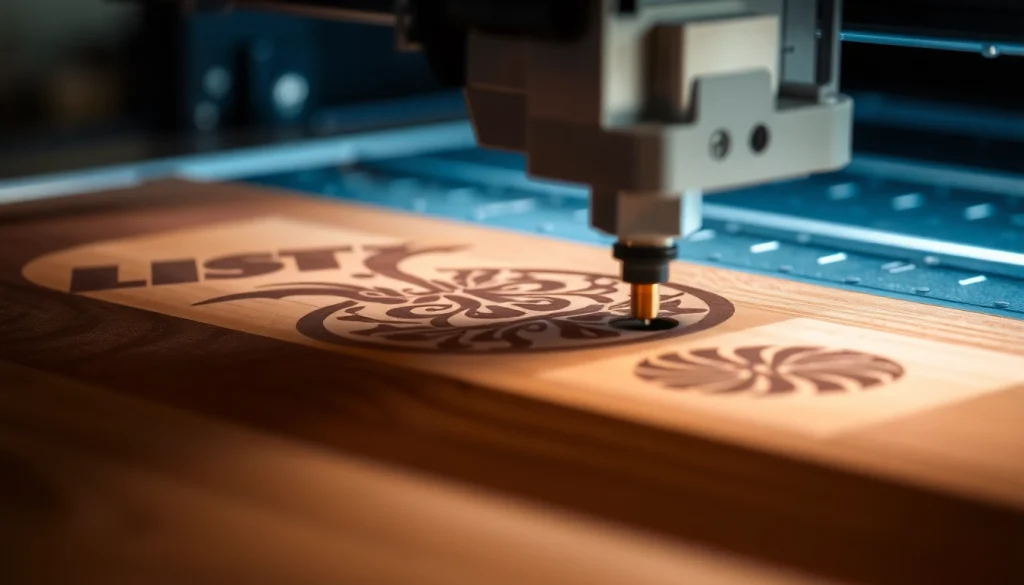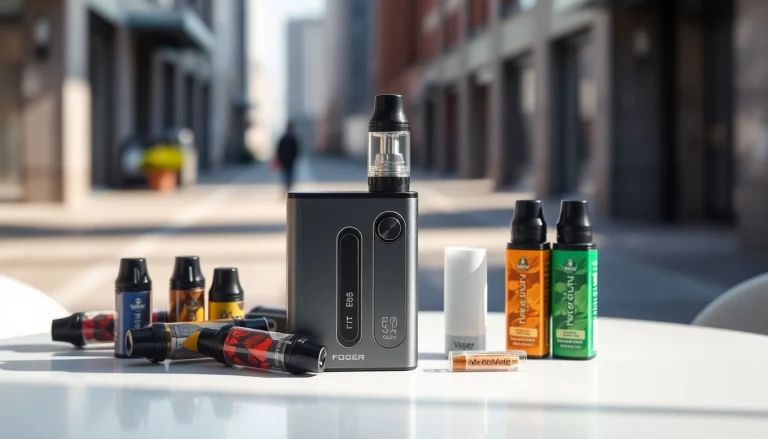
Understanding Laser Engraving and Its Applications
What is Laser Engraving?
Laser engraving is a cutting-edge technology that utilizes a laser beam to create inscriptions, designs, and patterns on various materials. By using a focused beam of light, the laser effectively removes material from the surface, resulting in intricate designs that are permanent and of high quality. This process is known for its precision and ability to create detailed engravings, making it a popular choice for customization in a variety of industries. Not only does laser engraving deliver top-notch results, but it also allows for unparalleled versatility, enabling creators to personalize products with names, logos, and intricate designs.
The technology behind laser engraving varies according to the specific material being used and the desired outcome. Laser engraving machines are equipped with various laser types, such as CO2 and fiber lasers, each suitable for different applications. CO2 lasers are primarily used for engraving non-metal materials like wood, acrylic, and glass, while fiber lasers are optimal for metals and some plastics. As both efficiency and quality are key to successful projects, understanding the best practices surrounding laser engraving is crucial for businesses looking to achieve exceptional results.
For businesses seeking tailored solutions, our laser engraving services are designed to meet your specific needs, allowing you to harness the full potential of this advanced technology.
Industries That Benefit from Laser Engraving
Laser engraving finds applications across numerous industries. The flexibility and precision of the technology allow businesses of all sizes to benefit from its capabilities. Below are some industries that frequently utilize laser engraving:
1. Manufacturing and Production: Precision part marking and custom components are essential in the manufacturing industry. Laser engraving offers reliable solutions for labeling parts, ensuring they meet production standards.
2. Promotional and Branding: Businesses looking to create branded merchandise often turn to laser engraving for personalized gifts, awards, and promotional items. It allows companies to imprint logos and designs with clarity and style.
3. Art and Craft: Artists and crafters utilize laser engraving to create intricate designs on various surfaces. This technology helps bring creative ideas to life, producing unique art pieces, decorations, and custom engravings.
4. Jewelry: In the jewelry business, personalization is paramount. Laser engravers can etch names, dates, or meaningful symbols into precious metals or stones, making each piece distinct and special.
5. Consumer Goods: Items ranging from kitchenware to electronics can be customized with laser engraving. This personalization adds sentimental value and differentiates products in a competitive market.
In conclusion, the adaptability of laser engraving technology empowers numerous industries to enhance their offerings and meet consumer demands.
Advantages of Using Laser Engraving Technology
The benefits of laser engraving extend beyond mere aesthetics. Here are some significant advantages of using this technology:
– Precision: Laser engraving provides unmatched precision, producing highly detailed designs that are consistently accurate.
– Speed: Compared to traditional engraving methods, laser engraving significantly reduces processing time, enabling faster delivery without compromising quality.
– Versatility: From metals to plastics and wood, laser engraving can be performed on a broad selection of materials, making it an ideal choice for various applications.
– Minimal Material Waste: The laser technology is highly efficient, reducing waste and optimizing material usage, which ultimately translates to cost savings for businesses.
– Environmentally Friendly: Laser engraving is a cleaner process that produces less hazardous waste, aligning with sustainable business practices.
– Customization: Fast prototyping allows businesses to create customized designs quickly, meeting the specific needs of clients and enabling more innovative product development.
The combination of these benefits makes laser engraving an attractive option for businesses aiming to elevate their production processes and product offerings.
Types of Materials Suitable for Laser Engraving
Common Materials: Wood, Metal, Acrylic
Laser engraving is compatible with a vast array of materials, empowering businesses to choose the best options for their products. Among the most common materials are:
– Wood: A favorite choice for artisans and manufacturers alike, various types of wood can be engraved to create stunning designs. The rich grain of wood also adds depth and character to engravings.
– Metal: Items like aluminum, stainless steel, and brass are particularly well-suited for laser engraving. The process leaves a durable mark that withstands wear and tear, making it an excellent option for branding and part identification.
– Acrylic: Perfect for signage and decorative items, acrylic can be laser engraved to produce clean and precise designs that are visually appealing. The material also allows for backlighting, enhancing the effect of the engraving.
These materials not only enhance the aesthetics of products but also offer durability and functionality.
Special Materials: Glass, Leather, 3D Crystal
Laser engraving services can also accommodate specialized materials, providing options for unique applications. These include:
– Glass: Using laser engraving, businesses can create elaborate designs on glass surfaces without compromising the integrity of the material. Whether for personalized gifts or corporate decoration, laser-etched glass serves as a high-end option.
– Leather: Personalized leather goods resonate deeply with consumers seeking custom products. Laser engraving on leather creates exquisite designs and patterns, adding a personal touch to wallets, bags, and apparel.
– 3D Crystal: This innovative material allows for sub-surface engraving, where images and text are etched within the crystal itself. The 3D effect creates stunning displays and awards that captivate attention.
Engraving these special materials opens new avenues for creativity and personalization, allowing businesses to stand out in their respective markets.
Challenges of Engraving Various Surface Types
While laser engraving offers numerous advantages, it is crucial to acknowledge the challenges associated with certain materials. Factors such as thermal conductivity, material thickness, and surface texture can impact the engraving process. For instance:
– Reflective Metals: Metals like mirror-finish stainless steel can be challenging. Adjustments in laser settings are often necessary to prevent reflections from interfering with the engraving process.
– Uneven Surfaces: Laser engraving requires a flat surface for optimal results. Materials with textures or contours may lead to uneven engraving, resulting in incomplete designs.
– Thermal Sensitivity: Some materials, particularly plastics, can be sensitive to heat. Careful calibration of laser intensity is required to avoid burning or distortion.
Addressing these challenges involves careful planning and expertise to ensure high-quality results. By understanding how different materials respond to laser engraving, businesses can avoid potential problems and deliver exceptional products.
Cost Savings Through Efficient Laser Engraving
Comparing Laser Engraving Costs with Traditional Methods
Investing in advanced laser engraving technology can lead to significant cost savings when compared to traditional methods. Conventional engraving techniques often involve manual labor and intensive processes, which can drive up production costs. In contrast, laser engraving dramatically reduces the time and resources required.
Laser systems, once in place, can be operated with minimal intervention, allowing for higher outputs and lower labor costs. Additionally, the precision offered by laser technology minimizes the likelihood of errors and waste, effectively cutting down on material expenses. In the long run, businesses that adopt laser engraving enjoy a favorable return on investment due to increased productivity and lower operation costs.
Minimizing Waste and Maximizing Efficiency
Efficiency is a critical factor in any manufacturing process. Laser engraving excels at minimizing waste through its ability to utilize materials effectively. The precision of laser technology ensures that each engraving is exact, translating to less scrap material and lower disposal costs.
Furthermore, automated processes can significantly reduce lead times, altering how businesses deliver goods to their clients. By embracing laser engraving, organizations can optimize their operations while addressing the demand for sustainability and reducing overall production costs.
Strategies for Reducing Overall Production Costs
To maximize the cost savings associated with laser engraving, consider implementing these strategies:
– Batch Processing: Engraving multiple items in one run can dramatically decrease the cost per unit. This practice allows businesses to make full use of the machine’s capabilities while reducing setup times.
– Material Optimization: Assessing the material waste generated during the engraving process can identify areas for improvement. By selecting the right materials for specific applications, companies can maximize their return on investment.
– Regular Maintenance: Keeping laser systems well-maintained ensures they operate efficiently, reducing the risk of costly downtime or repairs.
By focusing on these strategies, businesses can further enhance their profitability and sustainability through laser engraving processes.
Fast Turnaround Times in Laser Engraving Projects
Importance of Timely Project Delivery
In today’s fast-paced business environment, speed is of the essence. Customers increasingly seek quick turnarounds without sacrificing quality. As a result, having a reliable method to produce goods rapidly is invaluable.
Fast turnaround times in laser engraving allow businesses to respond promptly to customer requests and stay ahead of their competition. Companies that can consistently deliver quality products quickly often enjoy better customer loyalty and satisfaction.
How We Ensure Prompt Service Without Sacrificing Quality
At ManCave Machining, we understand the importance of speedy service. Our commitment to efficiency ensures that every project, big or small, is completed on time without compromising on quality. To achieve this, we:
– Implement streamlined workflows that prioritize efficiency, from the ordering process to production and shipping.
– Utilize advanced technology that allows high-capacity output while maintaining high accuracy levels.
– Employ skilled technicians who can adjust quickly to any challenges that may arise during production, ensuring that deadlines are met.
By combining experience and expertise with cutting-edge technology, we provide results that align with our clients’ expectations for quality and timeliness.
Real-Life Examples of Rapid Turnaround Success Stories
To illustrate our commitment to quick delivery, we can highlight several occasions when ManCave Machining successfully met tight deadlines:
– Corporate Events: We received an urgent request for branded awards just three days before a corporate gala. With efficient project management, we produced high-quality engraved trophies and ensured their timely delivery, much to the client’s delight.
– Custom Gifts: A customer approached us with a last-minute request for personalized wedding gifts. Our streamlined processes allowed us to produce beautifully engraved items within 48 hours, adding a special touch to the event.
These success stories underscore the intersection of speed and quality at ManCave Machining, reinforcing our reputation as a leader in rapid production.
Customer Satisfaction: Our Commitment to Excellence
Collecting Client Feedback for Continuous Improvement
At ManCave Machining, customer satisfaction is paramount. We actively seek input from our clients to ensure we meet and exceed their expectations. Collecting feedback allows us to identify areas for improvement and underscores our commitment to delivering top-tier services consistently.
Through surveys, direct communication, and follow-up interactions, we engage with clients to understand their experiences with our laser engraving processes. This communication not only fosters relationships but also drives our continuous improvement initiatives.
Case Studies: Satisfied Clients and Successful Projects
Highlighting successful collaborations with satisfied clients showcases our dedication. Here are a few notable examples:
1. Local Business Promotion: A local clothing company requested a set of custom tags for their products. Using laser engraving, we provided durable tags that featured their logo and product information, significantly enhancing their brand visibility.
2. Personalized Awards for a Non-Profit: We collaborated with a non-profit organization to create custom awards for their annual gala. Our timely delivery and attention to detail ensured that the awards were met with enthusiasm and appreciation from the recipients.
These case studies exemplify how laser engraving can create impactful products that resonate with clients and their audiences.
Building Long-Term Relationships Through Quality Service
At the heart of our approach is the goal of nurturing long-lasting relationships with our clients. The essence of any successful partnership lies in trust and reliability. As such, we prioritize delivering quality service consistently to ensure our clients come to us for their future projects.
By maintaining open lines of communication and demonstrating our commitment to excellence, we cultivate loyalty and satisfaction. Our clients know they can depend on us for their needs, leading to positive word-of-mouth referrals and repeat business.
Through our focus on customer satisfaction, we build a community around ManCave Machining that thrives on collaboration and shared successes.



